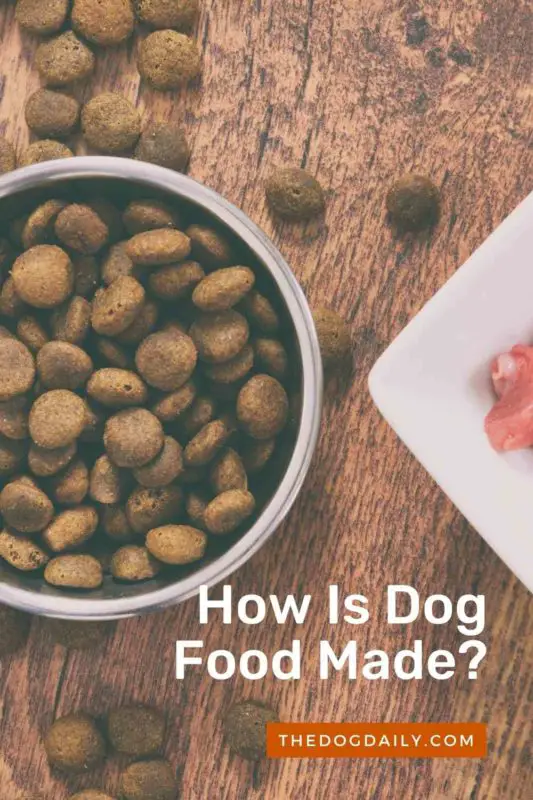How Is Dog Food Made?
The latest archaeological evidence suggests that dogs were domesticated as early as 26,000 years ago. It’s incredible to consider that commercial dog food dates back fewer than 200 years. So how did packaged dog food emerge and evolve?
James Spratt’s Mid-1800s Breakthrough
Before a better understanding of dogs’ nutritional needs developed, people mostly fed dogs dribs and drabs from human food stores. Feeding scraps of people food held for shipyard dogs, which used to gobble down hardtack biscuits. These biscuits, which are still available today, were just crunchy, wheat-based crackers that stored well.
According to Stephen Zawistowski, science advisor for The American Society for the Prevention of Cruelty to Animals, one day in the mid-1800s, lightning rod salesman James Spratt had a light bulb moment while he was standing on a dock.
Spratt, from Ohio, “watched how dogs would eat up hardtack biscuits on fishing docks, and thought, ‘I could make something similar,'” says Zawistowski.
Spratt compressed beetroot, various other vegetables, meat, and wheat into cakes and baked them, and the first manufactured pet food was born. He called it a “Meat Fibrine Dog Cake” and cleverly printed ads on the opposite side of dog show flyers, which he created and controlled with business partner Charles Cruft, founder of Crufts dog shows.
At around this same time, says Zawistowski, small-business owners — often working through farm animal feed operations or veterinary offices — started selling their pet food products to locals. Horsemeat was a popular ingredient in early dog foods since horses were plentiful then. (Using horsemeat for pet food was outlawed in the U.S. in the 1970s.)
Early Dog Food Advertising Fuels Interest
Advertising targeted dog owners, with celebrities of the time serving as spokespeople. For example, Zawistowski says that posters of Admiral Richard Byrd, a famous explorer who went to the Arctic and Antarctic, featured photographs of Byrd in the tundra with his dogs. At least one pet food company even paid Byrd to travel around the world and promote dog food.
Regulated Products and the Birth of AAFCO
With the growing popularity of commercial pet products came a need for regulation. In 1909, the Association of American Feed Control Officials was founded to oversee pet food quality. To this day, quality pet foods feature an AAFCO nutritional adequacy statement that indicates that the food is complete and balanced for a particular life stage. Kurt Gallagher, communications director of the Pet Food Institute, reported that AAFCO paved the way for canned dog foods, “with regulations established in 1917 for canned pet food products.”
1950s Machinery Breakthrough in Dog Food Manufacture
The two World Wars put a dent in businesses, but during the high-growth 1950s, snack food manufacturing resulted in another ingenious moment. Astute observers, watching cheese puff extruders turn out tasty bites, had the idea that such machinery could produce dry pet foods with yummy, nutritious coatings, says Zawistowski. This discovery resulted in the first pellet-sized dry foods, similar to those still sold today.
During the early- to mid-20th century, new influential entrepreneurs associated with companies like Purina, Hill’s Pet Nutrition, and Iams forged new commercial ground. Paul Iams, for example, “worked as a dog food salesman during the Depression,” according to Jennifer Bayot of The New York Times. “Not even severe economic hardship, he learned, could deter pet owners from paying the price to feed their companions.” Iams created some of the first meat-based, high-protein foods for pets, emphasizing quality and good health. Gallagher says that, at the same time, interest in pets began to skyrocket. “Dog food sales in 1958 were $298 million,” he says. “In 2010, they were about $12 billion.”
Continued Emphasis on Quality and Growth
To this day, most dog owners wish to feed their pets foods that contain high-quality ingredients with health benefits. The “eat healthy” trend kicked in during the late 1960s, with momentum building each subsequent year. We all want to live longer, healthier lives, and that extends to our dogs as well. “The pet food industry continues to grow and expand,” says Zawistowski. “Even during the toughest economic times, owners want the best for their pets.”
Dog Food Manufacturing Today
The process of making high-quality commercial dog food involves scientists, nutritionists, veterinarians, and even dog-food tasters in a production more befitting the Food Network than Animal Planet.
“They’ve got as many Ph.D.’s and doctorates on staff as any of the pharmaceutical companies,” says Dr. Katy J. Nelson, an emergency veterinarian who works on pet nutrition. “They’re trying to make a product that is going to be the sole thing that these animals are going to survive on, so they have to make sure they have everything that could be needed to sustain life and enhance the well-being of these animals.”
Find the Right Dog Food Recipe
It can take years for new dog food to progress from a concept to a food you can buy at your local pet store. Besides keeping up with the latest nutrition and scientific research, pet food makers also work with dog owners to explore what would best meet particular dogs’ needs beyond the basics. “Getting the idea is the easy part,” says Nelson. “Developing the food and making it into a great product is the hard part.”
Adds Dr. Amy Dicke, a Dayton, Ohio-based veterinarian who has worked with teams of nutritionists and researchers: “Innovative nutrition starts with research.”
Here’s how the different stages of developing a new dog food recipe usually progress:
- Formula development.
- Dog food formulas have their beginnings with research teams that include nutritionists, behaviorists, and veterinarians, says Dicke. During this stage, raw ingredients are evaluated for functional qualities, nutrient availability, and digestibility.
- Product and process development.
- Many factors can affect dog food formulas, such as cooking temperature, cooking duration, and even the order in which ingredients are added, says Dicke. Dog food makers will produce small sample quantities of test formulas in their laboratories and make adjustments to find the best combination of production efficiency, production capability, and nutritional enhancement for every formula.
- Analysis.
- An expert team of chemists, biologists, microbiologists, and lab technicians evaluates the test dog food formula for proper nutrients.
- Palatability testing.
- “Even the most nutritious pet food is worthless if the dog or cat won’t eat it,” says Dicke. During this stage, dog food formulas are tested by dog taste-testers. Instead of primarily relying on pets in a research setting, some pet food makers now recruit dogs for palatability testing in their home environment.
- Digestibility testing.
- Researchers don’t stop after determining which dog food is more palatable to dogs. They also test to understand how much of the nutrients in the food are absorbed by the body. “This tells us how well the formula’s nutrients are retained and how well they contribute to the pet’s health and well-being,” says Dicke.
Before new dog foods are sold, they must be complete and balanced and meet the nutritional adequacy expectations of the Association of American Feed Control Officials (AAFCO), which regulates pet food labeling in the United States.
Pet food makers are always looking for volunteers to help test foods. “Many companies feel like in-home usage gives you more realistic information about how pets are going to do on this diet because it incorporates the stresses of everyday life — both good and bad,” says Nelson.
Article written by Author: Jennifer Viegas and Elizabeth Wasserman

